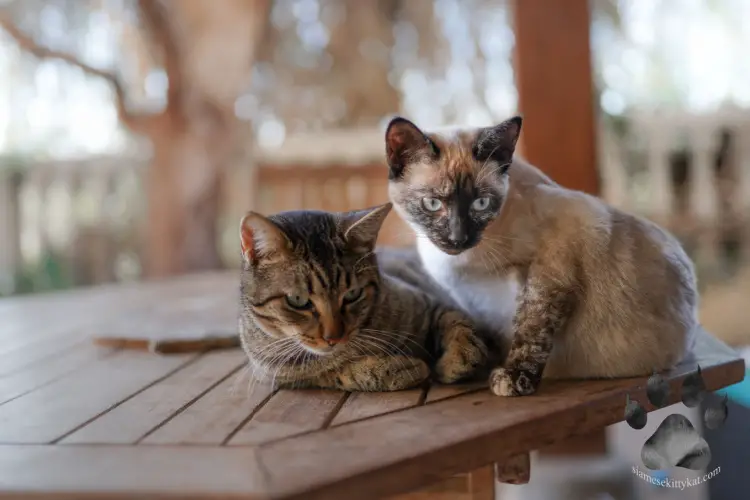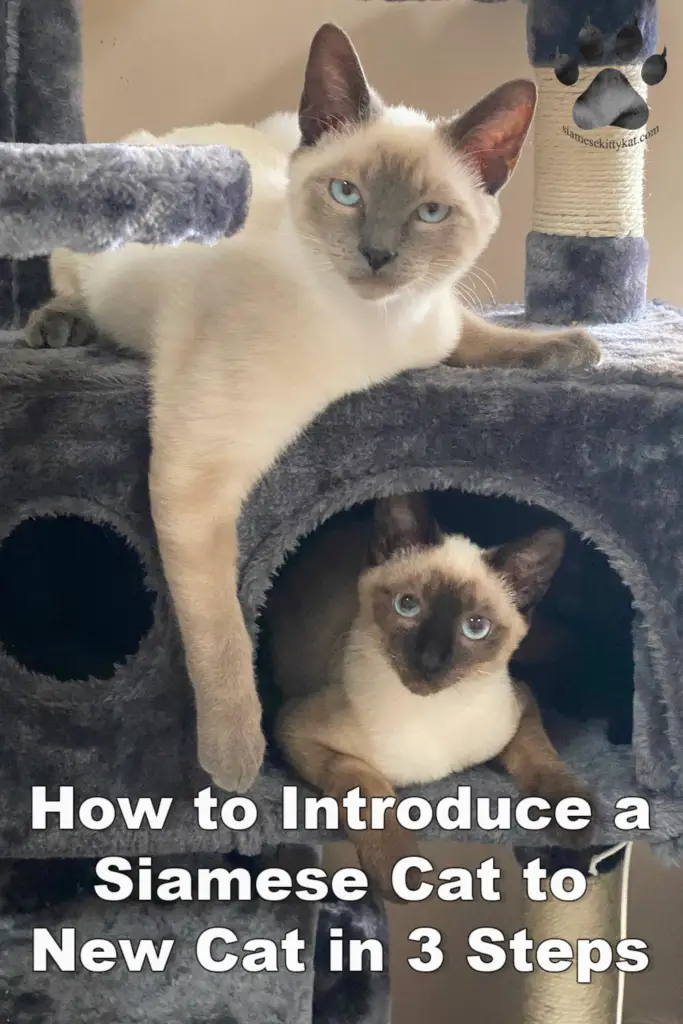Siamese cats crave lots of attention, love, and affection, whether through their human parents or other pets in the household.
However, it is also no secret that Siamese kitties are the jealous type. If the attention isn’t on the 99.9% of the time, you may find yourself in a bit of trouble.
Due to this jealous streak, it can be rather difficult to introduce new pets into an existing household, especially if your Siamese has ruled the roost for several years.
If you know the correct method, It is very possible to introduce a new kitten or cat into your home. The key to it all is taking things slowly, and not pushing either cat too far too early.
In this article, I’ll be letting you in on 3 steps you can take to ensure all your fur babies live in a happy and safe environment!, as well as helping you find the perfect partner in crime for your lovable Siamese.
Do Siamese cats get along well with other cats?
Due to their personalities, Siamese cats need a companion. Whether that be one with hands or one with paws, as long as they are not alone, they’re happy.
Felines are known for being very independent creatures. Many people opt for a cat since they don’t have time for a dog.
Siamese cats, however, are unlike your common moggie. These kitties thrive in numbers, and you will notice a distinct difference in Siamese cats who have buddies and those who do not.
It’s not uncommon for Siamese cats to become depressed and anxious if they don’t get the love and attention they need. Due to this, many people adopt two Siameses together. Typically this as siblings, or bringing them into a household with existing cats.
Siamese are loved and adored worldwide since they are incredibly loving by nature, and get along well with anyone or anything. That being said, certain breeds get along better with the Siamese. This is usually down to their energy level and playful personalities.
Which breeds get along with Siamese cats?

When searching for a new buddy for your Siamese, it’s best to look out for the following traits:
The following breeds get along well with the Siamese:
On the other hand, there are also some breeds and traits you should steer clear of:
How to introduce a Siamese to a new cat?
Take it from me, I know how difficult introducing new cats can be. Several years ago, I brought a new cat home in hopes he’d be buddy-buddy with my resident Siamese.
Much to my dismay, my Siamese didn’t take a liking to him very much. At first, I couldn’t understand why. They had similar personality times, and both had tons and tons of energy.
What I soon came to realize was that my Siamese was simply jealous. He didn’t like the fact he had to “fight” for attention. I thought this was game over.
I managed to solve this, however, by ensuring my Siamese never felt left out. If I was petting one, I’d always make sure the other had cuddle space.
Thankfully my new kitty didn’t mind when my Siamese got more attention than him. Over time, they began to warm up to each other, and my Siamese realized that having a new buddy around the house wasn’t all that bad.
The key to a successful introduction is taking it slow. This could take days, weeks, or even months. It’s all up to your cats and how comfortable they feel around one another.
It may be tempting to rush the process, but I can assure you things will go much smoother if you have patience.
3 steps to successfully introducing cats

Step 1: Keep them separated
Even if you have no resident cats at home, new kitties should always be kept in a separate room. This makes them feel comfortable and allows them to get a scope of the area and new smells.
For resident cats, separation can help them get used to the presence of the new cat. After all, this is their home so they’ll be feeling territorial and uncomfortable.
Ideally, the new cat should be put in a room where the resident cat doesn’t spend so much time. So, if your Siamese loves cuddling up with you in bed, you should keep the new kitty in a different room.
A good way for them to get used to each other’s scents is by swapping their bedding every now and again. You can also let your kitty play with some of your Siameses’ toys.
You’ll know when you’re ready to move onto the next step when both cats are feeling comfortable. For your Siamese, they will seem less stressed and the same as they were before the arrival.
The new cat should be exploring their surroundings without feeling nervous or stressed. So, if they’re still hiding under the bed or desk, give it some more time.
Step 2: Positive associations
By now, both cats will become comfortable with the idea that they are not alone, and naturally, they will be curious. However, don’t mistake this as them being 100% ready to meet – they will still be fearful of the idea.
A great way to let your kitties know that spending time together is a good thing is positive associations. This is usually in the form of treats.
First, figure out which treat both cats love. From now on, they are only going to be rewarded with this particular treat when in the presence of the other cat. However, if your cats prefer a reward in the form of playing or brushing, you can do this instead.
Keep in mind, presence doesn’t refer to direct contact. They’re still in the early stages of interacting, therefore they need to be separated by a baby gate or something similar – where they can see each other, but not touch.
You should never force either cat to be together. If they are curious, let them approach the gate in their own time. A little bit of encouragement (such as playing in front of the gate or giving treats) is fine, as long as they are comfortable.
Positive signs include:
Signs you need to slow down include:
Step 3: Direct contact – supervised
You should only move onto this stage once you’re sure the cats are comfortable with each other and no fights will break out. Keep the treats on hand so you can continue to reward them when they positively interact with one another.
If you spot any aggression or negative signs, try using a toy as a distraction. Always try your best to end the hangout on a positive note, and over time you can extend this interaction under close supervision.
Once both of your cats have spent a few days – or even weeks – positively interacting with no negative energy or stress, they are ready to hang out alone.
How can you stop a cat fight?
Conflict can happen, and sometimes there is no avoiding it. Therefore you have to be prepared to split up a fight if one ever does break out.
- Block off the space – Many fights start with a chase. Chasing will involve running and hiding, whether that be in a closet, under the sofa, or under the bed. Once they’ve both scrambled under something, it can be a lot more difficult to break up the fight. So be sure to seal off anywhere you feel like your kitties may escape to.
NOTE: Remember, cats are like liquid. You’ll be surprised what small spaces they can both squeeze under!
- Have something to block their sight – Taking the problem out of their line of view can help your cats calm down. This can also be used to safely guide them out of the room. This item shouldn’t be see-through, should be strong enough so they can’t jump through, and tall enough so you don’t have to get in the middle of them.
- A blanket – Sometimes, no matter what you do, your cats will not budge. They’re very stubborn creatures, and once they’ve got their sights locked on something, it can be hard to remove it. So, when all else fails, gently throw a blanket over one of them and scoop them up inside. You can then remove them from the room.
Do Siamese cats get jealous?
Since our cats have no way to tell us how they are feeling, it can be difficult to know whether they’re happy with the new changes. We can also never truly understand if animals perceive emotions the same as us and on what level.
However, animal behaviorists have found that cats do indeed get territorial, and do certain things to establish their dominance. Siamese cats particularly feel territorial over their surroundings and humans.
This need to be on top can often be perceived to us as jealousy.
If your Siamese is jealous of the new addition to your household, these are the signs:
What are the types of jealousy in Siamese cats?
According to cat behavioral specialists, there are 3 different aggression they use to define jealousy.
1. Inter-cat Aggression
Inter-cat aggression is used to describe the jealousy we see when one cat envies another. Typically, this is seen between two male cats, however, it can also be found in any gender and age.
This jealousy often occurs due to hormones. So, if your cats haven’t been spayed or neutered yet, doing so could curb this aggression.
2. Status Induced Aggression
Just like many other animals in the animal kingdom, cats have a social structure that allows them to feel more or less dominant than other humans and animals. This is often referred to as “impulsive control aggression.”
This type of aggression will include:
This type of jealousy actually stems from anxiety. A cat who is feeling this way will have doubts whether or not the human or animal is a threat. This aggression is an attempt to gain control over their environment.
3. Territorial Aggression
Cats are territorial by nature – Siamese kitties even more so. So, when they feel like someone or something has disturbed their safe haven, they may come across as aggressive.
This will include hissing and possibly attacking the stranger – in this case, your new cat. If you have ever taken one of your cats away for a while, maybe to spend a few nights in the vets, the resident kitty may feel some territorial aggression.
How can I stop my Siamese from being jealous?
Thankfully there are a few ways we can help reduce the jealousy in our Siamese kitties. All you need is patience and determination!
Spend More Time With Your Siamese
We all know that Siamese cats crave lots and lots of attention. It’s only natural that the time you spend with your Siamese will now be divided between the two cats.
To put it straight, your Siamese will hate this. So, it’s important to give them a bit of extra attention during the warm-up phase.
Here are some ways in which you can do this:
Of course, you shouldn’t neglect your other cat while you’re doing this, especially if they’re a Siamese. It’ll just require you to give 150% instead of 100%.
Create A Calmer Household
As I mentioned previously, playing with your Siamese will help them become relaxed. Cats who have a lot of pent-up energy will be more aggressive and are prone to fighting.
Siamese cats are very intelligent, so it’s good to give them games and puzzles that really help stimulate their minds. If your cats will allow it, you can also play with them together to help with positive associations.
Toys are also a great way to keep them both distracted when a fight breaks out. Physically interfering may cause you to get hurt, so using a toy such as a feather wand may take your Siameses eye off the other cat.
Another way to create a calmer household is using a calming diffuser. You can find one of these in your local pet store or from your vets. Ensure you find one that uses 100% natural ingredients.
These diffusers mimic the pheromones your cat gives off in order to feel safe.
Believe it or not, seeing a stray cat from outside the window can also heighten your cat’s stress levels. This will sometimes result in the cats fighting in order to get out that stress. Closing the curtains at night time will help curb this.
Give Them Their Own Space
It’s normal for cats in a two or more cat household to feel intimidated. So, you will have to work on giving both of your cats more confidence.
While Siamese cats typically dislike being alone, you do need to ensure they have plenty of space to retire to. This can include cat trees, window perches, and anywhere that includes high ground. This way, they won’t always be forced to be together or walk past each other.
You should always ensure you have more than one litter box at home. Cats are super territorial when it comes to using the bathroom, so an extra box could be what you need. A litter box with a lid may also be a good option since it will help them feel less cornered.
Keep their food and water separate. Cats become territorial over their food, so feeding them together may cause an argument to break out. You can also feed your Siamese before your new cat to establish a rank within the household.
Teach Your Siamese To Accept It
Sometimes, you just have to teach your Siamese that they won’t get their way. You can’t avoid your new pet, so you have to help them deal with the change.
This can include rewarding good behavior related to your new kitty. For example, you can pet your Siamese while you’re sitting next to your new cat. You can also play with your Siamese while the new kitty is around.
Re-introduce Your Cats
If all else fails, you may have to re-introduce your cats all over again. This should be your last resort since it usually takes a few weeks to do. However, it will definitely be worth it in the long run.
You will have to separate your cats once more. Swap their blankets and bedding to get them used to each other’s smell in a calm and safe environment. Once they begin to feel more at ease, you can begin from step one and eventually move up to supervised visits.
This may seem like a huge step back, but don’t give up! It also doesn’t mean you necessarily did anything wrong during the initial introduction. With your time and patience, your kitties can become friends once more.
A Happy Pair
Siamese cats love having a friend around, whether they met them at birth or a few years down the line. As long as you introduce them slowly and ensure both are always feeling comfortable, there is no reason why they can’t be the best of friends.
Want to immerse yourself more in the captivating world of Siamese cats? I’ve got all the information you need from their distinct color points to their fun personalities: Siamese Cats: Unique Features and Personality
Get your FREE Siamese Cat 2024 Printable Calendar


